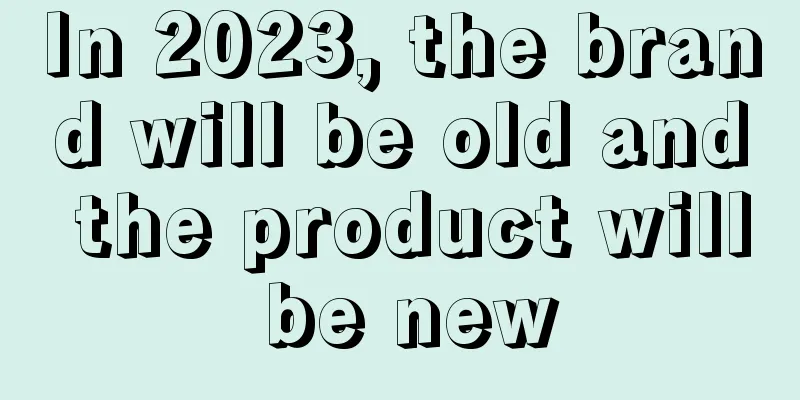In 2023, the brand will be old and the product will be new

This is the first time I have written a long article this year. See the final article of last year [10,000-word interpretation] Stop discussing "dividends" and return to common sense. We have extracted four methods to drive growth, many of which have been verified one by one in the first three months of this year. In the first three months, we asked many brands and their opinions were basically the same as ours. Recovery has not yet arrived and consumption is weak. A typical situation is: if the brand has prepared big promotions for Valentine's Day and Women's Day, including the Taobao New Force Week that just passed, it may feel as if "nothing happened." If the first three years were difficult with frequent storms and fighting various short-term uncertainties, this year is like walking through the desert, carrying a long burden and having difficulty discerning direction. In the macro sense, the State Council has set the economic growth target at 5% in 2023. In addition, in the post-epidemic era, judging from overseas experience, the risk of reinfection still exists, as well as the risk of deglobalization, increased geopolitical conflicts, overseas economic recession, negative population growth and aging, the popularity of Chatgpt and AI substitution theory, etc. These complex factors are intertwined and superimposed, causing uncertainty in the longer term. Not sure when things will really get better. Given the general environment, when we look at current consumption trends, we find that:
The mixture of macro and micro factors, coupled with the double internal circulation on the supply side and the flow side, made the start of the consumer market this year very difficult. What is the corresponding overall strategy for this? After three months of initial battle and in-depth discussions with peers, our answer is these eight words: make the brand old and the product new. 1. Brand agingBefore we talk about this topic, let’s clarify the meaning of “brand” - because every time we talk about this concept, we find that the differences in people’s understandings are incredible. Quoting the viewpoint of Humanistic Business Review again: (very insightful and brilliant)
The biggest problem with the Buzz Word faction is that they say things that sound extremely correct, but almost no one can understand them if they are told to any normal human being in real life. And anything that cannot be explained in "human language" is most likely nonsense. So let’s return to the common sense of brands and use the simplest words: what is a brand? Brand is the recognition of consumers for its products and services. Marketing is one of the ways to achieve recognition, and advertising is one of the tools of marketing. For some categories, recognition is equal to approval, such as low-priced fast-moving consumer goods, services or daily necessities, as long as you can afford them. For other categories, appreciation is equal to approval, such as high-end clothing, perfumes, accessories, digital fashion products, etc. Back to our topic today, what is "brand aging"? In an environment where various uncertainties coexist, "old brands" - familiar brands - are more likely to gain recognition from consumers because they have greater certainty. "Old" means familiarity, predictability, and stability of the value provided. To make it easier to understand, we will discuss how to "become an old brand" for three different types of consumer brands. 1. Positioning brand, taking the route of extreme single product - being a "familiar neighbor"Positioning brands, such as Xiaoxiandun (bird's nest), Wang Xiaolu (chicken feet), Qia Qia (melon seeds), Xiaodu (smart assistant), Lin Qingxuan (camellia essential oil), etc. ... Single products are the first association of a brand or even a category. For positioning brands, the significance of "brand aging" lies in continuously consolidating the recognition of core products among the mainstream population and becoming a neighbor that everyone is familiar with - seeing each other every day, having a good reputation around, and knowing each other well. In the past, the methods were relatively simple. Due to the concentration of media discourse power and information transmission, and the less intense competition on the supply side, neutral advertising + channel distribution could basically accomplish the task of "consumer recognition", that is, "cognition" = "recognition". Now, with information complexity and fierce competition, the ways and means of becoming a "familiar neighbor" have changed. For example, if Wang Xiaolu had advertised on major TV stations in the 1990s, its marketing position is now the mid-roll ads on major video websites. This is a change in the media, not a change in marketing logic. Just like in the past, people greeted each other in person, but now they like their posts on WeChat Moments. For some other categories (where prices are not so low, decisions cannot be made easily, or competition is fierce), "recognition" cannot be completely equated with "recognition". Therefore, at this time, if you want to "become an old brand" and become a familiar neighbor, you still need to do two things:
It is worth mentioning that we must correctly understand the role of "planting grass" in the "brand recognition" level. As former Coca-Cola CMOS Lu Xiuqiong said, "In today's China, you can't enter the mainstream population just by relying on product promotion," because for a brand that focuses on extreme large-scale products, it needs sufficient recognition; and product promotion is difficult to scale up in batches, and it is difficult to solve the problem of consistency in information communication (the purpose is to get others to recommend, and it is illogical if everyone repeats the same thing). Secondly, let’s talk about “knowing everything” – if a company wants to become a “familiar neighbor” for consumers, it must not only know them, but also understand them. Therefore, companies should not only tell the public who they are, but also communicate what they have done to make you trust them enough. This is what we call the brand hidden line in the "Brand Marketing Full-Link Operation Method Course": convey through brand stories and product stories. The specific ways to tell stories are all in the course, you can take a closer look. The higher the customer unit price of a single product, or the higher the repurchase rate, the more it is necessary to let consumers "know everything about it". To sum up, for brands that focus on large single products and positioning, based on the perspective of "brand aging" (giving users certainty), they should become a "neighbor that everyone is familiar with."
2. Social brand - be an active member with stable outputHeytea, Luckin Coffee, Yongpu, Holiland, KFC, McDonald's, Hema... are all social brands, constantly launching new products to arouse topics, discussions and interests. Social brands also need to adhere to "brand aging". There is a phrase that describes it very well, called "dispersed in form but concentrated in spirit". That is, a product can have countless ideas and creativity, but looking at the entire brand through the product, there is a consistent style, stable output and distinct personality. For example, Yongpu Coffee, unlike other products that are keen on joint brands, Yongpu's style has a strong sense of stability and consistency: fairy-tale colors, freshness, and design full of exploration and curiosity. From a superficial perspective, the design style and expression elements are very stable, which is even better than Heytea (Heytea has been a bit too messy in its recent joint ventures, and even some of it has weakened the tone of its own brand). From a deeper perspective, Yongpu has a stable spiritual pillar - creating a "coffee island". As the founder described: "All users who buy Yongpu products are equivalent to landing on Yongpu Island. As Yongpu islanders, consumers will be protected in all aspects of life." This may sound childish, but in fact, consumers hope to be healed by something cute or gentle in life. Yongpu Island is derived from the human desire for companionship, which is the spiritual connotation of the brand. This point supports the unlimited extension of the product, truly bringing people together. As a social activist with stable output, Yongpu's design, imagination and brand personality are consistent, meeting users' continuous expectations of it. To sum up, social brands can increase their presence and discussion by constantly launching new products. But at the core, a stable degree of recognition still needs to be established - when people consume social products, in a sense, they are pursuing an "experience-based" experience. Each brand represents a preferred way of experience. Therefore, social brands also need to build their own core concepts and values, which is the foundation of "brand recognition." 3. Lifestyle brand - be the "circle of friends" of a certain type of peopleA lifestyle brand refers to building a lifestyle to attract target groups that match or aspire to it. For example, MUJI, Neiwai, lululemon, IKEA, Xiaohongshu, Guanxia, etc. People need such brands to fully present their self-worth or lifestyle. It is like a user's "circle of friends" to show aesthetics, taste, image, and life interests. In other words, lifestyle brands are centered on "serving a group of people" rather than "big single products" that serve "collective needs". This group of people have their own unique preferences in values and lifestyles. The long-term value delivery of a brand must be highly consistent with their lifestyles. The significance of this type of user choosing a brand is to showcase themselves as part of their "circle of friends." Therefore, lifestyle brands are the ones that need to be “aged” the most, because users hope that their external expressions (for personal shaping) are consistent. For example, Neiwai insists on women's self-awareness awakening and bold expression, Patagonia insists on environmentalism, and NetEase Yanxuan praises anti-routine and individual expression. Lifestyle brands usually use design to show life taste, content to express life philosophy, and events to show life attitude, gradually forming a unique brand style, so that a group of people with highly similar characteristics can find a familiar, certain, and stable style tool for self-expression. 2. Product innovation"Innovating products" is undoubtedly the growth weapon this year: On the traffic side, new products are free topics and hooks; on the channel side, new SKUs and new combinations of products can effectively balance the disputes between different channels over prices and commissions; on the competition side, horizontal category extension and vertical population expansion are growth paths that every brand needs to consider; innovation is risky but must be done, through continuous iteration and trial and error of new products, the team's ability to launch new products can be continuously honed. The situation that companies like Hutouju are facing now will make more companies cautious. Compared with high-cost investment methods such as store expansion and traffic increase, using products to increase volume has lower risks and smaller investments, and the growth may not be so aggressive, but everyone still tends to seek stability this year - a slight increase in stability. How to make a product new? Back to the three types of brands: 1. Positioning brand, horizontal expansion of single product market spaceFor this type of brand, big single products are a double-edged sword: It is a moat that firmly binds the brand and category together, making it more likely for users to think of and buy it. But it also builds a wall for itself. The possibility of category expansion and brand extension is low, because it is very difficult for consumers to migrate their minds from one product to another based on deep-rooted impressions. Therefore, close relevance is the most important factor to consider when making new products. The usual choice is to continue the core large single product strategy and expand the single product space horizontally, including: (1) Basic attribute extension That is, create more SKUs based on the basic dimensions of core products: For example, snacks can be fully extended according to factors such as packaging, flavors, and combinations to occupy more shelves and fill the user's 1234567 options, preventing competitors from taking advantage of loopholes. They can also be customized and segmented according to the needs of different channels to prevent random pricing: for example, in the Douyin live broadcast room, a special flavor can be customized to increase profits and try to break even on the cost of paid traffic; and for top influencers, another product combination can be customized separately to take the cost-effective route to meet differentiated pricing policies and gift needs. (2) Upgrade and iteration of core products The Nth generation, upgraded models, latest models... Whether it is the 3C digital, automotive or beauty and skin care industries, the iteration and upgrade of the most core products are all tools to fully utilize brand potential and increase the awareness of users to purchase or repurchase. (3) Seizing the upper and lower price bands This is also the most common practice, it is worth noting that: To harvest new customers by lowering prices, you need to stabilize the brand’s mindset. For example, Tesla launched low-priced models and Zhong Xue Gao launched low-priced ice cream at 3.8 yuan. Only when the public has a clear understanding of the quality represented by the brand can they use the brand’s potential to release attraction downwards, achieve the goal of exchanging profits for market share, and allow people with lower willingness to pay to become consumer users. If you take the high-price route and make a high premium, you can gain new high-net-worth people and profit space, which can be divided into two situations:
(4) Extension of the same category population In recent years, many restaurants have begun to promote "parent-child meal takeout", and sports brands have also begun to promote the "children's sports series" - focusing on the same category of needs, using new products to enter different groups of people, thereby gaining growth. Note that if the "consumer decision maker" is the same person, for example, the buyer of the "parent-child series" is still the parent, then the difficulty of category migration will be lower because there is already a foundation of brand recognition and trust. A good example is the Elvis speaker. This brand has always been focusing on retro speakers with high appearance, which are very popular among girls. Last year, it launched a new Bluetooth speaker with a more mechanical and cyber style, targeting young men. However, in the definition and promotion of the product, this product was defined as a "gift from girls to boys", which means that the decision makers are still girls. 2. Social brands: multiple ways to open up new product spaceFor social brands, there are more new ways to make products new, and they can also be made lighter and smarter: (1) New scene The product remains unchanged, but giving it a new scenario can also create new incremental space A typical example is "convenience store cocktail making". Young people go to 24-hour convenience stores, choose their favorite base liquor, juice and drinks, etc., and make their own cocktails. In various scenarios (convenience stores, living rooms, dormitories, offices and even outdoors), they can create a unique tipsy atmosphere for themselves - the same product, different scenarios, can expand new demand space. The same is true for the "brewing tea around the fire" that was popular last year. Products such as tea and snacks were implanted in a new social scene, which immediately triggered a wave of attention and interest in consumption. Products with new usage scenarios or that can be combined with new trends are things that social brands should always keep an eye on and think about. (2) New elements In the creation of new products, implanting the new element of "empathy with young people" is also an efficient way to gain incremental growth. Nostalgic elements: Luckin Coffee and Coco Tree’s Coconut Cloud Latte, the collaboration between Heytea and The Legend of Zhen Huan… nostalgia is always a killer. Provocative elements: Using some potentially "disliked" and controversial elements can often increase discussion and topics to a greater extent, such as McDonald's coriander sundae, KFC's carrot Americano, and the recent chive egg tarts. Cute elements: Hitting the cute point is equivalent to hitting the selling point, such as the combination of Luckin Coffee and the striped puppy, Starbucks' cat paw cup and McDonald's cat bed. Cultural elements: Incorporate traditional cultural elements into products, such as seasons, solar terms, and intangible cultural heritage. (3) New level replacement Social brands are very suitable for the concept of "substitutes" because the supply chain and channels are more flexible, the risk of new product launches is small, and consumer expectations are more controllable (people buy new products to try them out and generally don't spend much). In addition, this year's general trend of consumption downgrade and austerity has made them more enthusiastic about substitutes. A typical example is the substitute for "Beef Wellington". In high-end restaurants, it may cost hundreds or even thousands of yuan, but many bakeries and even Pizza Hut have made substitutes: "Beef Wellington Bread", which costs only a few dozen yuan to enjoy the same delicacy. It has become an Internet celebrity in Guanglianshen and B&C. 3. Lifestyle brands: launch segmented concepts and update expressionsDifferent from the product logic of the previous two, lifestyle brands "create new products" based on human characteristics (rather than specific product or category needs). The product itself is the embodiment of the concept of life. Ubras was the first to launch size-free underwear. The reason behind this was not to meet the demand for "underwear should be size-free", but the pursuit of some women - freedom, including true physical freedom, no constraints, no judgment from others, consumption for one's own feelings, and freedom of time: no size distinction means no need to go to offline stores to try on and buy. Ralph Lauren launches a new spring and summer collection, focusing on the concept of the "female gentleman" - a more neutral, bookish lady. Under this concept, it launches a series of elegant (slightly yuppie) style, neutral-colored suits, vests, shirts, etc. The city series launched by Guanxia also extracts city-specific concepts through the preferences, characteristics, and personality of the target users' cities, and then carries them with specific products. Therefore, for lifestyle brands, "product innovation" means constantly refining "segmented concepts" or "new ways of expression" based on in-depth understanding of the crowd and a certain brand concept. For example, Ubra launched the soft support series, which is still based on the concept of freedom - no need to force yourself when encountering problems, "let the power of softness give us the freedom to not force ourselves." This is also the obstacle that many large single products encounter when they want to do business around the crowd. They are accustomed to defining products based on product logic and category demand logic, rather than focusing on people’s expression needs: products are just the extension and expression of life concepts. To borrow the humanistic expression, "what 'concept' you are selling determines the possibility of generating user resonance, and most critically determines the possibility of the first spontaneous conversion." Especially for new products, which do not yet have word-of-mouth or repeat purchasing users, the key to whether the launch will be successful lies in whether users recognize the concept it represents. The above is the model and method we explored in three different types of brands based on "product innovation". Finally, let's talk about marketing. It just so happens that in the "Full-link Brand Marketing Operation Method Course" of Yuruhemao, the course "How to Make a Successful New Product Launch" has been updated. The overall framework is as follows: The year 2023 will undoubtedly be a year when companies are frantically launching new products. Students who are interested can pay attention to how to increase the success rate of new product launches on the marketing side. In the entire course system, each part of the specific methods, including target groups, product selling points, channel planning (advertising, seeding, PR, activities, etc.), rhythm and tactics, etc., are clearly introduced and described. Finally, to sum up, the core logic of "making brands old and products new" is to explore growth space internally. When the external environment cannot provide sufficient growth drivers, growth can only be sought internally. The internal growth of an enterprise mainly comes from brands and products. The certainty of the brand reassures consumers, both in terms of functional guarantee and emotional support; and the "newness" of the product means exploring various possibilities based on needs and scenarios, increasing the chances of persuading consumers to try it. Brand building and product innovation are both basic skills of an enterprise, but it is precisely the basic skills that determine whether the company can move forward steadily and for a long time this year or even longer. Author: Taro WeChat public account: Taro and Cat Talk (ID: taro_cat) |
<<: With more than 10,000 followers per month, AI beauties are invading Xiaohongshu
Recommend
Real opportunities and strategic analysis of the consumer industry in 2023
The analysis of the consumer industry on the marke...
What should I do if there is no product size picture for cross-border products? What are the picture requirements?
Cross-border e-commerce must be able to make the m...
How much does a cross-border e-commerce store earn? How can merchants earn more?
More and more domestic merchants are opening store...
How to become a marketer who will not be replaced by DeepSeek?
AI can not only efficiently generate copywriting a...
Some post-00s speculate in stocks, while others speculate in “Valley”
In this article, we will take a deep look at the e...
When IP collaboration "goes beyond tea drinks": too many brands, not enough IPs | Inventory of collaborations in August and September
In the brand marketing arena, IP co-branding is se...
The "618" test is here: the melee is escalating, low prices are in circulation, and merchants are under pressure
What are the characteristics of this year's 61...
No one dares to be a big anchor anymore!
The article explores the current status of the liv...
Does Lazada need to consider VAT when calculating prices? How to set prices?
Lazada is still gaining momentum in Southeast Asia...
Which platform is better for Shopee cargo agency? How to choose?
When it comes to Shopee freight forwarding, many n...
McDonald’s collapsed, can Chinese burgers take over?
Explore the McDonald's food safety incident, a...
With a price tag of over 1,000, can this brand be successful in selling high-end down jackets on Douyin e-commerce?
This article mainly discusses the destination of e...
How to fill in the company code when registering for Amazon membership? What is the filling process?
At present, the cross-border e-commerce industry i...
How to train and improve business decision-making ability
Business strategy is the key to every company'...
Is SHEIN considered a big internet company? How is the work intensity and salary at SHEIN?
SHEIN (formerly known as SheInside) is a popular f...









